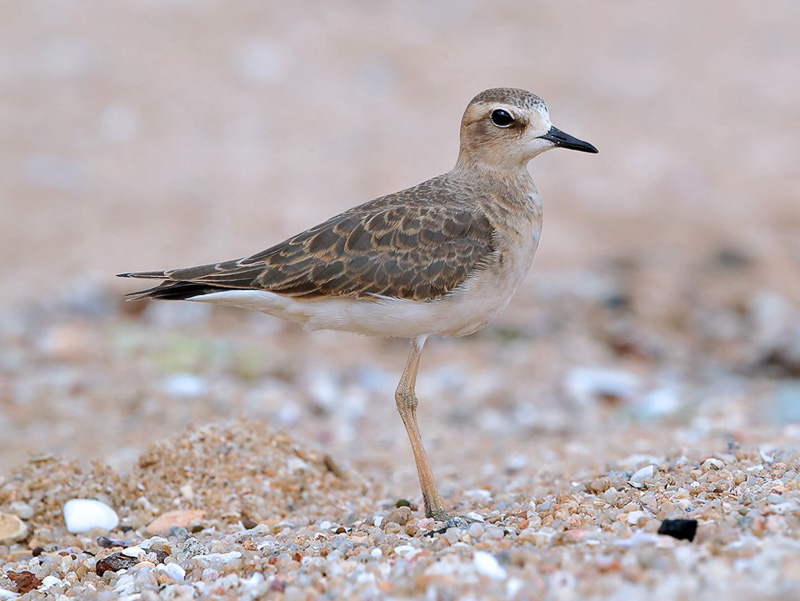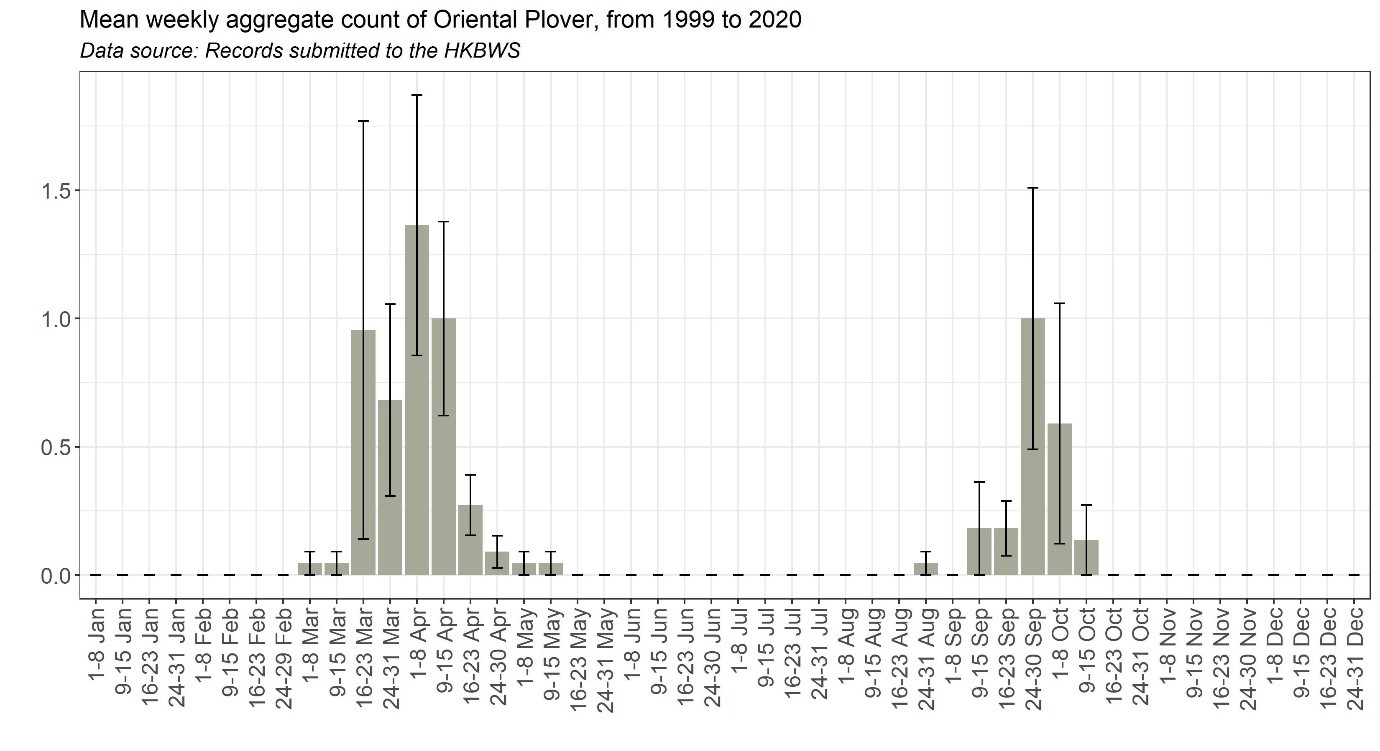Oriental Plover Anarhynchus veredus 東方鴴
Category I. Passage migrant in grassland, other dry open country sites and the Deep Bay area. Scarce in spring, rare in autumn.
IDENTIFICATION

Apr. 2003, Martin Hale. Male, breeding plumage.
22-25 cm. Male in breeding plumage has a very pale almost whitish head and neck with a brown hind crown and a rusty upper chest darkening to a blackish lower border.

Apr. 2019, Michelle and Peter Wong. Female.
Tall, long-legged, long-winged, elegant plover, with yellowish-orange legs and relatively long, slim bill. Female and juvenile is brownish-buff on the head and chest, with pale supercilium and dark crown and dull legs. Pale fringes to the upperparts occur on both, though they are broader on juveniles.
VOCALISATIONS
A moderately high-pitched ‘chip’ has been heard when in flight.
DISTRIBUTION & HABITAT PREFERENCE
Up to 1998 approximately 85% of records came from the airport sites of Kai Tak and Chek Lap Kok. Away from these sites there were only 16 records, nearly all in the Deep Bay area in spring, the exception being one at Lam Tsuen on 27 March 1960.
Since then, however, the number recorded on airfields has declined due to decreased observer activity in the airside areas at Chek Lap Kok. Most records are now from low-lying areas of the northern New Territories from Lam Tsuen through Kam Tin and Tsim Bei Tsui to Mai Po NR and nearby fish pond areas as well as the Lok Ma Chau MTRC Ecological Enhancement Area. Elsewhere, there were records of singles on Po Toi on 9 April 2019, at Pui O during 13-17 April 2013 and at Sai Keng, near Ma On Shan on 6 April 2018.
The preferred habitat is short grass, but it also occurs in other open country habitats such as freshwater marsh.
OCCURRENCE
Oriental Plover is a scarce passage migrant in spring but is rare in autumn (Figure 1). The earliest spring record is of one at Kam Tin on 5 March 2006 and the latest is of one there on 2 June 1978. The highest counts at this time have both occurred at airports: 18 on 22 March 2000 at Chek Lap Kok and 11 on 28 March 1979 at Kai Tak. In general, however, records refer to five birds or fewer. The main passage period is the second half of March and first half of April.
In autumn the main period of passage is the second half of September and first week of October, with extreme dates of 27 August 2017 and 27 October 1978. The highest count in autumn occurred at Kai Tak: 28 on 24 September 1979. A total of 19 were killed by aircraft during 27-28 September 1979, all of which were in first-winter plumage (Melville 1981). Apart from ten at Chek Lap Kok on 30 September and 1 October 2002, all other autumn records are of five birds or fewer.
The only pre-1958 records were of up to three from 8 March to 7 May (Herklots 1953, Dove and Goodhart 1955).
BEHAVIOUR, FORAGING & DIET
Not generally seen on the intertidal mudflats.
RANGE & SYSTEMATICS
Monotypic. Breeds from southern Siberia through Mongolia to northeast China, and winters in northwest Australia, sparsely in the south (Wiersma and Kirwan 2020, Liu and Chen 2021).
CONSERVATION STATUS
IUCN: Least Concern. Population trend unknown.
Figure 1.

Dove, R. S. and H. J. Goodhart (1955). Field observations from the Colony of Hong Kong. Ibis 97: 311-340.
Herklots, G. A. C. (1953). Hong Kong Birds. South China Morning Post, Hong Kong.
Liu, Y. and S. H. Chen (eds) (2021). The CNG Field Guide to the Birds of China (in Chinese). Hunan Science and Technology Publication House, Changsha.
Melville, D. S. (1981). Summary of birdstrike data from Kai Tak Airport, Hong Kong. Paper presented at 2nd ICAO Workshop on Reducing Bird Hazards to Aviation, Bangkok, 14-18 September 1981.
Wiersma, P. and G. M. Kirwan (2020). Oriental Plover (Charadrius veredus), version 1.0. In Birds of the World (J. del Hoyo, A. Elliott, J. Sargatal, D. A. Christie, and E. de Juana, Editors). Cornell Lab of Ornithology, Ithaca, NY, USA. https://doi.org/10.2173/bow.oriplo1.01

